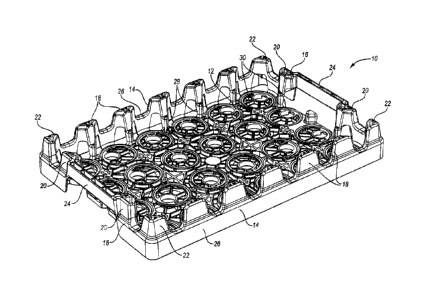Une partie des informations de ce site Web a été fournie par des sources externes. Le gouvernement du Canada n'assume aucune responsabilité concernant la précision, l'actualité ou la fiabilité des informations fournies par les sources externes. Les utilisateurs qui désirent employer cette information devraient consulter directement la source des informations. Le contenu fourni par les sources externes n'est pas assujetti aux exigences sur les langues officielles, la protection des renseignements personnels et l'accessibilité.
L'apparition de différences dans le texte et l'image des Revendications et de l'Abrégé dépend du moment auquel le document est publié. Les textes des Revendications et de l'Abrégé sont affichés :
| (12) Brevet: | (11) CA 2835778 |
|---|---|
| (54) Titre français: | PORTE-BOITES EMBOITABLE |
| (54) Titre anglais: | NESTABLE CAN TRAY |
| Statut: | Réputé périmé |
| (51) Classification internationale des brevets (CIB): |
|
|---|---|
| (72) Inventeurs : |
|
| (73) Titulaires : |
|
| (71) Demandeurs : |
|
| (74) Agent: | MACRAE & CO. |
| (74) Co-agent: | |
| (45) Délivré: | 2020-09-15 |
| (22) Date de dépôt: | 2013-12-06 |
| (41) Mise à la disponibilité du public: | 2014-06-06 |
| Requête d'examen: | 2018-08-21 |
| Licence disponible: | S.O. |
| (25) Langue des documents déposés: | Anglais |
| Traité de coopération en matière de brevets (PCT): | Non |
|---|
| (30) Données de priorité de la demande: | ||||||
|---|---|---|---|---|---|---|
|
Un porte-cannette emboîtable comprend une base ayant plusieurs parties de nervures verticales croisées. Plusieurs parties de murs horizontaux sont raccordés à des extrémités inférieures proches des parties de nervures verticales. Plusieurs cavités annulaires sont formés sur une surface supérieure de la base pour recevoir lextrémité inférieure des cannettes de breuvage. Le porte-cannette comprend également des parois latérales qui comprennent des colonnes latérales sétendant vers le haut à partir des parties inférieures des parois latérales sur les côtés de la base. Des parois dextrémité comprennent des colonnes dextrémité aux extrémités de la base. Les colonnes latérales sont configurées pour être partiellement recevables dans les colonnes latérales dun porte-cannette identique emboîté et les colonnes dextrémité sont configurées pour être partiellement recevables dans les colonnes dextrémité du porte-cannette identique emboîté.
A nestable can tray includes a base including a plurality of intersecting vertical rib portions. A plurality of horizontal wall portions are connected proximate lower ends of the vertical rib portions. A plurality of annular recesses are formed on an upper surface of the base for receiving lower ends of beverage cans. The tray further includes side walls including side columns extending upward from lower side wall portions at sides of the base. End walls include end columns at ends of the base. The side columns are configured to be partially receivable into side columns of an identical tray nested thereon and the end columns are configured to be partially receivable into end columns of the identical tray nested thereon.
Note : Les revendications sont présentées dans la langue officielle dans laquelle elles ont été soumises.
Note : Les descriptions sont présentées dans la langue officielle dans laquelle elles ont été soumises.

Pour une meilleure compréhension de l'état de la demande ou brevet qui figure sur cette page, la rubrique Mise en garde , et les descriptions de Brevet , États administratifs , Taxes périodiques et Historique des paiements devraient être consultées.
| Titre | Date |
|---|---|
| Date de délivrance prévu | 2020-09-15 |
| (22) Dépôt | 2013-12-06 |
| (41) Mise à la disponibilité du public | 2014-06-06 |
| Requête d'examen | 2018-08-21 |
| (45) Délivré | 2020-09-15 |
| Réputé périmé | 2020-12-07 |
Il n'y a pas d'historique d'abandonnement
| Type de taxes | Anniversaire | Échéance | Montant payé | Date payée |
|---|---|---|---|---|
| Le dépôt d'une demande de brevet | 400,00 $ | 2013-12-06 | ||
| Taxe de maintien en état - Demande - nouvelle loi | 2 | 2015-12-07 | 100,00 $ | 2015-10-07 |
| Taxe de maintien en état - Demande - nouvelle loi | 3 | 2016-12-06 | 100,00 $ | 2016-10-07 |
| Taxe de maintien en état - Demande - nouvelle loi | 4 | 2017-12-06 | 100,00 $ | 2017-10-06 |
| Requête d'examen | 800,00 $ | 2018-08-21 | ||
| Taxe de maintien en état - Demande - nouvelle loi | 5 | 2018-12-06 | 200,00 $ | 2018-10-09 |
| Taxe de maintien en état - Demande - nouvelle loi | 6 | 2019-12-06 | 200,00 $ | 2019-10-08 |
| Taxe finale | 2020-08-17 | 300,00 $ | 2020-07-06 |
Les titulaires actuels et antérieures au dossier sont affichés en ordre alphabétique.
| Titulaires actuels au dossier |
|---|
| REHRIG PACIFIC COMPANY |
| Titulaires antérieures au dossier |
|---|
| S.O. |